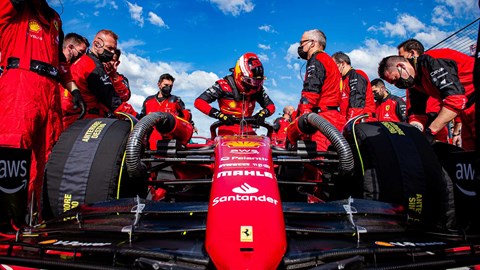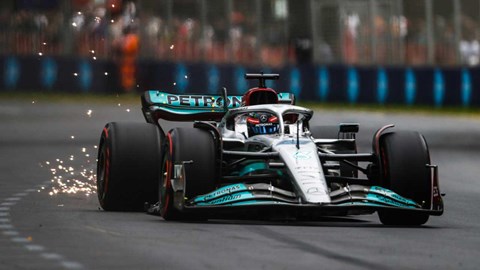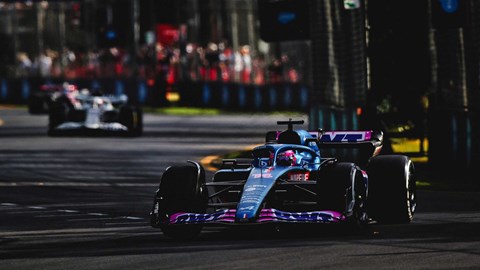► Third race of the year in the books
► Ferrari wins two out of three
► Another Red Bull DNF
F1’s return to Australia was the perfect antidote to the 2020 non-event on the brink of the Coronavirus pandemic. This year’s Melbourne GP was another action-packed but intriguing race, and it also began to surface the key narratives of 2022. It was another Ferrari win – again from Charles Leclerc – but this time he was followed by Sergio Perez’s Red Bull and finally George Russell’s Mercedes. So where were Sainz, Verstappen and Hamilton – and what clues did Australia give us for the rest of the reason? Keep reading for six things we learnt from the 2022 Melbourne GP.
1. One Ferrari is a title favourite
Charles Leclerc has always had the speed and the talent, but he’s becoming a winning machine. His season so far consists of two wins and a second place, but it’s the way in which he’s gone about them – with almost no mistakes at all – that is surely leaving other teams and drivers worried. The Monegasque was faultless in Melbourne and hasn’t shown any cracks under pressure either – unlike the rest of the field.

2. It could be a one (prancing) horse race
If Leclerc’s form is worrying for the other teams, it’s dreadful news for the other side of the Ferrari garage. Carlos Sainz hasn’t been able to get the most out of the Ferrari so far this year, and it’s left the Spaniard consistently trailing his teammate.
In Melbourne it went really wrong; after qualifying ninth, Sainz couldn’t make the hard tyres work on the opening laps, ultimately beaching the car and scoring no points. Leclerc now leads the championship with 71 points, while Sainz trails behind with just 33. That’s a gap for almost two race wins.
With Charles getting stronger every race, it’s very possible Sainz will soon be playing the role of Barrichello if things continue as they are. This is Maranello after all.
3. Mercedes does damage limitation
Rumours suggested Mercedes would bring updates to its ailing W13 in Melbourne, but it soon became clear the Brackley team had abandoned them. The reason? Paddock whispers say the team couldn’t afford to introduce updates that may not work – a direct consequence of the new cost-cap rules. With that in mind, the Silver Arrows haul of P3 and P4 was a great result for the team; and could be crucial at the end of the season.

Stranger still is the position of the Silver Arrows in the WDC and WCC; the Brackley team sits second in the constructors (albeit with 65 points to Ferrari’s commanding 104) and George Russell also sits in a distance second place behind Leclerc. Hamilton, meanwhile, finds himself three points ahead of Verstappen.
It’s clear the Mercedes isn’t competitive and will need serious development to get a sniff of the title race; but the team has managed to hoover up the points available. Red Bull on the other hand now trail both Mercedes and Ferrari with 55 points.
4. Red Bull engine reliability
Another race, another failure for Red Bull’s Max Verstappen. In a carbon copy of Bahrain, Max found himself outpaced by a Ferrari before a late technical failure left him leaving with 0 points instead of a certain 18. The problem? A possible issue with the fuel systems, though Red Bull says it’s not the same one as in Bahrain.
After the race team principal Horner said he’d rather fix a fast fragile car than a slow reliable one – though with Verstappen finishing (albeit winning) just one race out of three, it’s hard to follow the logic. The Milton Keynes team’s DNF means Ferrari is building a solid lead, and it’s possible Mercedes will soon be in the fight.

Interestingly, Sergio Perez’s Red Bull wasn’t affected this time, it was in Bahrain; his engineer said the issue was not relevant to his car…
5. How fast is Alpine and McLaren really?
New rules mean a volatile pecking order, and in Melbourne Alpine found itself even closer to the sharp end. Still, it’s once again a case of what might’ve been for Alonso: during a lap that will almost certainly have landed him in the first four positions, his hydraulic system failed and caused him to go off. It wasn’t a one-off thing, the double-world champion’s pace was mostly strong in the race too.
McLaren had a strong weekend, somehow replacing Haas as one of the leading midfield teams. Lando Norris continued to get the upperhand over his teammate, even pipping both Mercedes to a P4 grid slot. Still, home favourite Ricciardo’s P7 wasn’t bad either. Able to initially stick to the Mercedes cars, both McLarens lost contact during the race finishing 5th and 6th – but it was the strongest weekend by far for the orange team.

6. Pay drivers go under the microscope
The Saturday saw both Lance Stroll and Nicholas Latifi collide, in an accident that was ultimately deemed to be mainly the Aston Martin driver’s fault. Despite that, the whole event was pretty awkward, and I’d argue both drivers had to make it happen.
It was also yet another crash for Nicholas Latifi, who must surely be eating through his team’s R&D budget in repairs alone. Latifi’s trend of incidents – as well as Mazepin’s 2020 season – are slowly but surely reopening the debate on pay drivers: if fellow series such as Formula E, or even eSC don’t have them – should the pinnacle of motorsport?